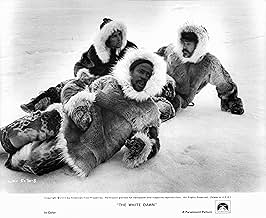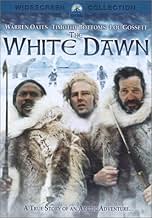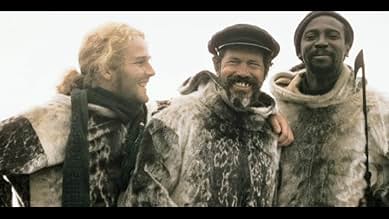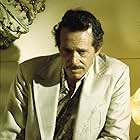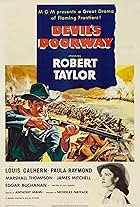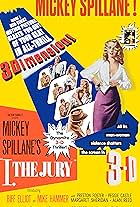In 1896, three survivors of a whaling ship-wreck in the Canadian Arctic are saved and adopted by an Eskimo tribe but frictions arise when the three start misbehaving.In 1896, three survivors of a whaling ship-wreck in the Canadian Arctic are saved and adopted by an Eskimo tribe but frictions arise when the three start misbehaving.In 1896, three survivors of a whaling ship-wreck in the Canadian Arctic are saved and adopted by an Eskimo tribe but frictions arise when the three start misbehaving.
Louis Gossett Jr.
- Portagee
- (as Lou Gossett)
Storyline
Did you know
- TriviaAccording to producer Irwin Winkler, this movie was the main factor in his decision to invite director Philip Kaufman to direct The Right Stuff (1983). Portions of Henry Mancini's score for this film can be heard in the later film.
- Alternate versionsThe film was originally given an "R" rating from the MPAA due to the nudity which was then edited for the film to receive a "PG" rating.
- ConnectionsReferenced in Realizing 'the Right Stuff' (2003)
Featured review
This movie contains what is surely one of the strangest, most unique, and most fascinating scenes in the history of cinematography.
The scene is of an Inuit (Eskimo) ritual. I believe it to be authentic. The screenwriter (who also wrote the original book) lived among and studied the Inuit people for decades and was probably one of the world's foremost (non-Inuit) experts on Inuit culture. Furthermore, the movie was filmed on location and using actual Inuit people as actors.
In the ritual, two girls sit cross-legged on the floor, facing each other. They seal their mouths together and take turns blowing air forcefully across the vocal cords of the other person. It creates one of the eeriest sounds I've ever heard. It's kind of a continuous huffing dronal chant, reminiscent of the background drone of bagpipes but without the shrillness. The strangest aspect of it is that there is an undertone of human voices in the sound. You get the feeling that if you listened hard enough, you could make out actual words. It is like no other sound you've ever heard - hair-raising. Who could have ever imagined that the human body could produce such a sound? Basically what they are doing is playing the other person's body like a musical instrument.
The girls continue doing this, apparently for hours, hardly stopping to take a breath. They've got to be hyperventilating, or experiencing a buildup of carbon dioxide in their lungs and blood, and it is incredible that they can go on and on like this without fainting. They must go into some kind of dizzy trance-like state.
I have never seen or heard of this ritual/technique anywhere but in this movie. I was in Alaska the summer of its Centennial year (1967) and was so fortunate to see a great many demonstrations of Inuit culture as part of the celebrations. But I didn't see anything like this, nor have I come across any description of it in my reading.
This movie would be worth seeing, preserving, and collecting on the basis of this one scene alone! (But actually the rest of it is also worth seeing.)
The scene is of an Inuit (Eskimo) ritual. I believe it to be authentic. The screenwriter (who also wrote the original book) lived among and studied the Inuit people for decades and was probably one of the world's foremost (non-Inuit) experts on Inuit culture. Furthermore, the movie was filmed on location and using actual Inuit people as actors.
In the ritual, two girls sit cross-legged on the floor, facing each other. They seal their mouths together and take turns blowing air forcefully across the vocal cords of the other person. It creates one of the eeriest sounds I've ever heard. It's kind of a continuous huffing dronal chant, reminiscent of the background drone of bagpipes but without the shrillness. The strangest aspect of it is that there is an undertone of human voices in the sound. You get the feeling that if you listened hard enough, you could make out actual words. It is like no other sound you've ever heard - hair-raising. Who could have ever imagined that the human body could produce such a sound? Basically what they are doing is playing the other person's body like a musical instrument.
The girls continue doing this, apparently for hours, hardly stopping to take a breath. They've got to be hyperventilating, or experiencing a buildup of carbon dioxide in their lungs and blood, and it is incredible that they can go on and on like this without fainting. They must go into some kind of dizzy trance-like state.
I have never seen or heard of this ritual/technique anywhere but in this movie. I was in Alaska the summer of its Centennial year (1967) and was so fortunate to see a great many demonstrations of Inuit culture as part of the celebrations. But I didn't see anything like this, nor have I come across any description of it in my reading.
This movie would be worth seeing, preserving, and collecting on the basis of this one scene alone! (But actually the rest of it is also worth seeing.)
- ghostofaredrose
- Mar 7, 2009
- Permalink
- How long is The White Dawn?Powered by Alexa
Details
Box office
- Budget
- $1,700,000 (estimated)
Contribute to this page
Suggest an edit or add missing content


